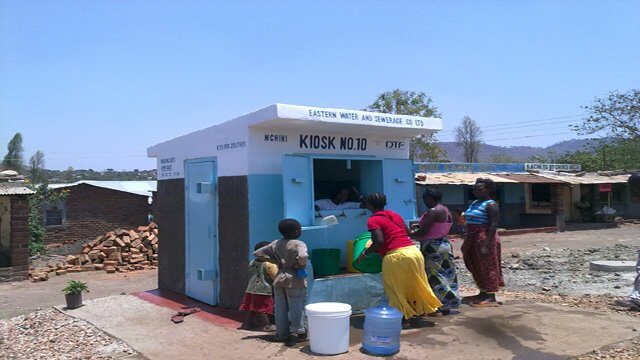
Are water kiosks the solution to limited clean water access?
RVE.SOL is quoted in a recent article on Kiosk Marketplace by Bradley Cooper. Read the full article here or see below text

March 13, 2015 by Bradley Cooper
Imagine that in order to get water to drink and bathe yourself, you had to walk miles every day to the nearest water source. Then, when you collect the water, you realize it is filthy and likely has millions of tiny disease-causing microbes in it. Yet, you don’t have any other options, so you fill up your container and make the long journey back to your home.
According to charitywater.org, unclean water causes the deaths of 30,000 people every week, and 90 percent of those deaths are children that are under five years old. In addition, charitywater.org says, “In Africa alone, people spend 40 billion hours every year walking for water. Women and children usually bear the burden of water collection, walking miles to the nearest source, which is unprotected and likely contaminated.”
“Water borne illness kills approximately three million people a year in Sub-Saharan Africa alone, 40% under age of five,” said Maria Burpee, marketing director for the sustainable development company RVE.SOL. “Often people will have just enough money to spend on anti-diarrhea tablets that are easier to access than clean water.”
There are several possible solutions to this clean water dilemma, one of which is water kiosks. Thewaterkiosk foundation in Switzerland has worked to establish water kiosks for 44 schools and 15 communities throughout Africa and Asia. These kiosks serve a total of 37,500 people. Other examples of successful water kiosk projects include the Naandi Foundation which supplied one village in India with a water kiosk for clean water supply. This kiosk was partially financed by the villages who set aside some of their money to help bring it to their community.
“Water kiosks provide an effective alternative to clean water access for low-income families in many developing countries, including in areas where WaterAid works,” said Elizabeth Jenkins, Program Development Officer for nonprofit WaterAid. “We use water kiosks as an alternative to household water connections, which are typically either subsidized, or paid for through a fee-based tariff system where each household pays a set fee for access to water.”
“Water kiosks if done properly could solve the problem of access to potable water in rural, developing areas if they were reliable enough to function in rugged connections but also have a source of power (solar for example) as most of those remote, rugged locations in developing nations will be off-grid,” said Burpee. “These renewable energy kiosks would be great for town centers or villages where the nearest, polluted water source is a very long distance away.”
However, there are some inherent challenges to deploying water kiosks. One is related to cost. Many citizens in third world countries simply are not willing to pay for these kiosks.
“We have seen families are sometimes not willing to pay for clean water when they can take their chances with dirty water,” said Burpee. “What happens is family income that could be used to buy clean water is prioritized on other things like weddings, funerals, healthcare, food, etc.” When citizens become used to a certain way of life, even if it is unsafe, it is difficult to convince them to make a change that will cost them money.
However, water kiosks remain a viable option for many impoverished areas. “Water kiosks are an effective tool to provide typically low-income users with more freedom and flexibility to pay as they use the water, especially in cases where they may not have the income to pay a routine tariff or to pay for a household connection from a water utility that may not function consistently,” Jenkins said.
When asked what Americans could do to help those in need of clean water, Burpee said, “Americans can purchase only from water suppliers that have a donation/charitable component as part of their brand, even better they can fund campaigns on Kiva with microloans, and in the extreme case, they can volunteer with organizations that are bringing access to clean water.”
Burpee’s solution to the clean water issue was installing minigrids in local communities. Minigrids are essentially solar powered hubs which provide electricity and energy to the communities. It also acts a water purification device. “The community brings the dirty water and it is then filtered and they are provided clean drinking water.”
Ultimately, any sustainable solution to the clean water dilemma will require the cooperation of communities, volunteers and donators. “The key is to give people the tools they need to become water management experts so that they can make their precious resources affordable, safe for consumption and sustainable year-round,” Jenkins said. “The fact that 1 in 10 people worldwide do not have access to clean, safe water is a crisis of monumental proportions, but it’s one that we have the tools and know-how to solve.”
(Image via Wikipedia.org)